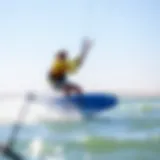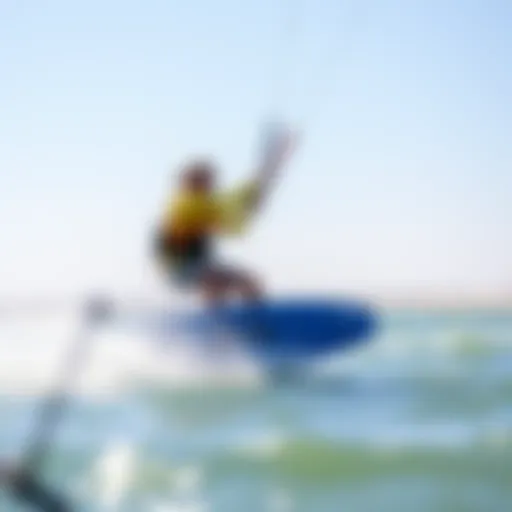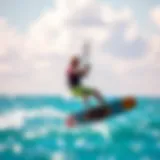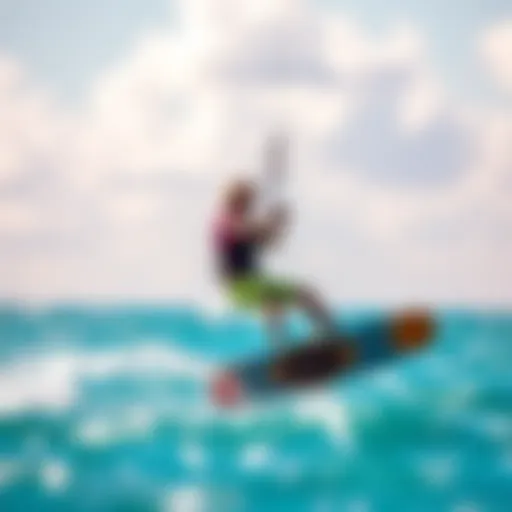Exploring the Ocean Rodeo Trainer Kite: A Comprehensive Guide
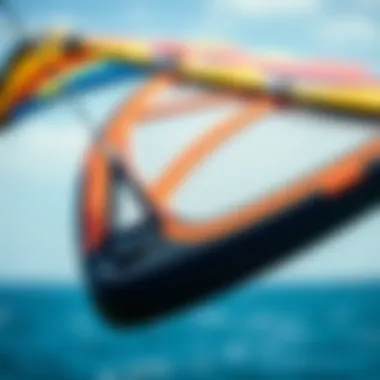

Intro
Kiteboarding, at its core, blends the thrill of flying with the freedom of the ocean. A good starting point for many is the Ocean Rodeo Trainer Kite. This kite isn’t just a tool; it’s often the first tangible step in developing kiteboarding skills. Through this guide, we’ll explore various angles—its design, practical uses, safety, and the broader kiteboarding community.
Understanding the workings of a trainer kite is crucial, whether you’re a budding snowboarder or a seasoned sea adventurer seeking to refine your craft. The Ocean Rodeo Trainer Kite invites kiteboarders into a unique realm of wind and water. Let’s dive in and see what makes this kite an essential companion for enthusiasts at all levels.
Gear Insights
Understanding your equipment is key in kiteboarding. The right gear can impact your performance and safety on the water.
Latest Gear Reviews
The Ocean Rodeo Trainer Kite has received positive feedback across various platforms. Its craftsmanship and attention to detail shine through. Users often note the lightweight structure, which makes flying in varying winds manageable. The colorful designs aren’t just for show; they also help with visibility, making it easier to spot on crowded beaches.
A standout feature has to be the easy inflate system. When it comes to setup time, this kite scores high, letting you hit the water faster. Typically, people find that trainers from Ocean Rodeo are more durable compared to others, with reports of them standing tall against tough conditions.
Essential Gear for Beginners
For those just starting, it’s vital to have the right accessories alongside your trainer kite:
- Control Bars: Proper bars enhance your ability to maneuver the kite without much effort; trust me, you do not want to cheap out on this!
- Safety Leash: Safety should never take a back seat. This helps in securing your kite and is a must-have while learning.
- Harness: Choose a harness that fits snugly. It’s easy to overlook, but a comfortable harness can make or break your session.
It’s also wise to consider weather specific clothing. The ocean can be unpredictable, so having the right gear on your back can protect you from wind chills or splashes.
Techniques and Tips
Once you’re familiar with the gear, it’s time to sharpen your skills. Here are some recommendations to get you started.
Advanced Tricks and Techniques
After securing the basics, advancing your skills can be exciting. Here are a few techniques that can elevate your kiteboarding game:
- Jumping: Master the art of jumping with your kite by practicing controlled take-offs. It’s not just about getting air, but landing smoothly as well.
- Transitioning: To improve your flow, practice transitioning smoothly from one direction to another. This is essential for staying in control while you ride.
Safety Practices for Kiteboarders
Safety should always be top of mind:
- Check Winds: Before tossing your kite into the sky, ensure the wind conditions are favorable for your skill level.
- Know Your Area: Familiarize yourself with the locations where you plan to practice. Understanding currents and local regulations can save you from nasty surprises.
- Buddy System: Practicing with a friend or instructor is a wise move. Not only does it double the fun, but it also enhances safety.
"Investing time in understanding your equipment pays off in ways that simply get you more time enjoying the ride."
Whether you're just getting your feet wet or you're well into your kiteboarding journey, the Ocean Rodeo Trainer Kite stands as a beacon for skill development and enjoyment. This guide aims to cast light on its multifaceted role in your kiteboarding evolution.
Preface to the Ocean Rodeo Trainer Kite
In the vast realm of kiteboarding, the significance of the Ocean Rodeo Trainer Kite cannot be overstated. For both beginners and seasoned riders, this kite offers a foundation that hones essential skills while providing a safe and controlled environment to explore the wind's potential.
Understanding Trainer Kites
Trainer kites are specifically designed as an entry point into the kiteboarding world. They serve several purposes, particularly for those just starting their journey. With their smaller size and lighter construction, trainer kites are easier to control in various wind conditions. They allow learners to grasp the basic mechanics of kiting without being overwhelmed by the complexities of larger inflatables.
The Ocean Rodeo Trainer Kite, in particular, showcases a thoughtful design that prioritizes user-friendliness. Its forgiving nature means that beginners can take their time getting to know the wind's whims without the kite steering them in unexpected directions. Additionally, these kites are often equipped with durable materials that can withstand the rigors of a learner's practice, making them a worthwhile investment.
The benefits extend beyond just learning to control the kite. Trainer kites facilitate an understanding of how to harness wind power. This knowledge translates well into the transition to larger kites, improving the student's initial experience in kiteboarding. Moreover, their portability makes it easy to take them to a nearby park or beach, offering flexibility in practice locations.
History of Ocean Rodeo
Ocean Rodeo began its journey in the early 2000s, carving out a niche in the competitive field of kiteboarding gear. The company's dedication to innovation is evident in its comprehensive range of products, aimed at optimizing performance and safety.
Since its establishment, the brand has evolved, responding to advancements in technology and the needs of its users. The introduction of the Trainer Kite highlighted its commitment to accessibility in kiteboarding. Notably, the company focuses on the fusion of high-quality materials with functional design, ensuring each kite provides a robust and memorable learning experience. As a result, Ocean Rodeo has become synonymous with reliability, becoming a go-to choice for many aspiring kiteboarders.
"The journey of learning to kiteboard is just as important as the thrill of the ride itself. The Ocean Rodeo Trainer Kite not only equips you with skills but also builds your confidence in the sport."
The evolution of the Ocean Rodeo Trainer Kite reflects both technological advancements and a broader understanding of what learners need. It embodies the company's philosophy of enhancing the kiteboarding experience, paving the way for future developments and innovations.
This section sets the stage for a deeper exploration into the design features and functionality of the Ocean Rodeo Trainer Kite, as we unfold its intricate dynamics in the subsequent sections.
Design Features of the Ocean Rodeo Trainer Kite
The design features of the Ocean Rodeo Trainer Kite play a pivotal role in elevating the kiteboarding experience for both enthusiasts and newcomers. Understanding these elements not only enhances performance but also ensures that users can harness the full potential of the kite, providing a gateway to mastering the art of kiteboarding. Key considerations around design include material construction, the range of sizes and shapes, and innovative inflation mechanisms that contribute uniquely to this kite's functionality.
Material Construction
The materials used in constructing the Ocean Rodeo Trainer Kite are crucial in shaping its durability and performance. Typically, the canopy is crafted from high-quality ripstop nylon or similar fabrics, which are torn resistant and lightweight. This not only minimizes the overall weight of the kite but also makes it robust enough to withstand wear and tear, especially in rugged kiteboarding environments.
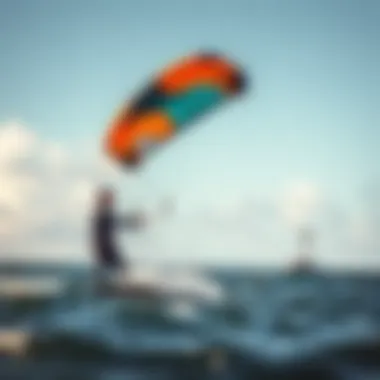

- Abrasion resistance: When you're out there battling the elements, having a material that can shrug off scrapes and impacts from other gear or the water itself is a must.
- UV Protection: Look for materials that offer UV resistance, extending the life of the kite under continuous sun exposure.
- Water Resistance: Most trainer kites come with water-repellent finishes, allowing for quick drying and maintaining performance without sogginess weighing it down.
This blend of components ensures that the Ocean Rodeo Trainer Kite maintains its structure, integrity, and performance over time, giving users confidence in their gear whether they're just starting or honing their skills.
Size and Shape Variations
The size and shape variations of the Ocean Rodeo Trainer Kite are thoughtfully designed to cater to a broad range of skill levels and preferences. Kites are available in multiple sizes, from smaller models ideal for young or lightweight users to larger kites that offer more lift and traction for advanced riders.
- Small Kites (1.5m to 2.5m):
- Medium Kites (2.5m to 3.5m):
- Large Kites (3.5m and above):
- Best suited for novices or those learning the ropes
- Easier to control and provides a gentler learning curve
- Good for intermediate riders ready to push their limits
- Versatile in different wind conditions
- Designed for experienced kiteboarders looking for high performance
- Greater power and speed in kiteboarding maneuvers
The shapes of these kites vary considerably, sometimes featuring Delta or Bow configurations that enhance stability and ease of use. A rounded shape tends to give more lift, while a flatter shape provides increased speed. Choosing the right size and shape can directly affect how quickly one progresses in their kiteboarding journey.
Inflation Mechanisms
Inflation mechanisms in the Ocean Rodeo Trainer Kite are engineered for efficiency and usability. A well-designed inflation system is critical, ensuring that the kite can be launched and controlled without unnecessary hassle.
- One-Pump System:
- Offset Valves:
- Quick Deflation:
- This allows for rapid inflation of the leading edge and struts simultaneously, saving time.
- Ideal for quick setups, particularly when conditions are changing.
- Positioned thoughtfully to prevent accidental deflation when connecting or disconnecting the inflation pipe.
- With a simple twist or release mechanism, these kites can be deflated rapidly, making packing them down a breeze.
The Functionality of the Trainer Kite
Understanding the functionality of the Ocean Rodeo Trainer Kite is paramount for anyone looking to hone their skills in kiteboarding. These kites serve as the cornerstone for beginners as well as a tool for seasoned riders refining their technique. The balance between control, maneuverability, and responsiveness determines how effective the kite is in different conditions. Let's break down three essential features that highlight the kite's function in a practical setting.
Launching and Landing Techniques
Launching and landing a trainer kite requires a good grasp of technique, influenced by wind direction and personal positioning. Here are some steps to consider:
- Setting Up: When laying the kite out on the sand or grass, make sure it's arranged in a "T" shape with the leading edge facing into the wind. This orientation allows for easier inflation and decreases the risk of unexpected takes.
- Launch Sequence: As you start the launch, one should gently pull on the rear lines while someone holds the front edge, ensuring it rises smoothly.
- Landing Method: To land, it's crucial to steer the kite directly overhead before steadily letting the lines slack. This directs the kite to descend without abrupt movements, safeguarding both you and any spectators around.
These techniques might sound straightforward, but they require practice. Each launch and landing contributes to muscle memory, making these skills second nature over time.
Basic Controls and Steering
Control over a trainer kite is akin to guiding a ship through treacherous waters. Understanding the basic controls can make all the difference:
- Bar Input: The control bar plays a pivotal role; pulling it closer will generate power, while pushing it away effectively depowers the kite.
- Turning the Kite: To turn, a simple pull on one side of the bar is all it takes. The kite reacts almost instantly, giving you feedback on how much pressure appropriate with the wind speed at the time.
- Body Position: Leaning your body in the direction you want the kite to go enhances control. Adding your own weight into the turning dynamics allows for smoother transitions.
Adapting these controls while keeping the wind dynamics in mind will prepare you for any unexpected gusts that may arise.
Harnessing Wind Power
The very essence of kiteboarding lies in harnessing wind, and understanding this element can translate to improved performances.
- Positioning Relative to Wind: Keeping the kite at a proper angle allows you to maximize pull without losing control. Ideally, the kite should be kept within the 10 and 2 o'clock positions in relation to the wind.
- Angle of Attack: A slight adjustment of the kite's angle can lead to significant changes in power. Tilting the kite more towards the wind increases lift, while tilting it away reduces it.
- Consistency and Flow: Maintenance of a constant speed while cutting through the water is essential. This requires harmony between body movements and kite actions.
By mastering these elements, enthusiasts become better equipped to ride the waves with confidence.
"Great kitesurfers don’t ride just the waves; they ride the wind itself."
In summary, the functionality of the Ocean Rodeo Trainer Kite envelops launching and landing techniques, steering controls, and the intuitive harnessing of wind power. Understanding these components not only enhances the experience but also contributes indispensably to the development of adept kiteboarders.
Training Techniques with the Ocean Rodeo Trainer Kite
The art of kiteboarding hinges significantly on a solid understanding of training techniques, especially when it comes to using the Ocean Rodeo Trainer Kite. For beginners, these techniques provide the essential foundation needed to master kite control. Intermediate practitioners can use them to refine their skills, while experienced kiteboarders can hone their maneuvers in a controlled setting. There’s always something new to learn, and each technique plays a crucial role in your development as a kiteboarder.
Beginner Training Approaches
Learning to navigate the skies with a trainer kite is akin to learning to walk before you run. Beginners should start by familiarizing themselves with the basic components of the sail, such as the leading edge, trailing edge, and bridle lines. A strong focus on kite safety is paramount. The following approaches are worth considering:
- Wind Window Exploration: Understanding how the kite interacts with the wind is essential. Beginners should practice flying the kite in various parts of the wind window to comprehend how wind direction affects lift and power.
- Hand Placement Techniques: Mastering how to grip the control lines can dramatically improve reaction times. Ensuring both hands are correctly positioned notably aids in steering and controlling the kite effectively.
- Controlled Hovering: Learning to keep the kite stable in a stationary position helps develop a sense of control. This exercise can be performed on land, allowing new kiteboarders to feel the kite's pull without the added complexity of water.
Engaging in these exercises not only builds confidence but also paves the way for more advanced skills down the line.
Intermediate Skill Development
As practitioners move beyond the beginner stage, they begin to explore more complex maneuvers. Intermediate skill development with the Ocean Rodeo Trainer Kite can greatly enhance one's capabilities. The following techniques play a key role:
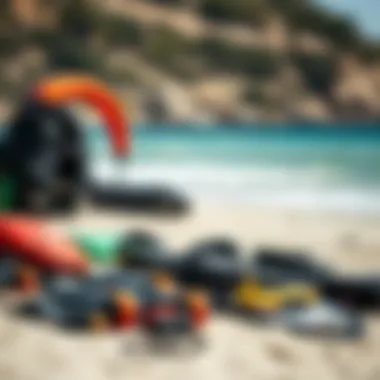

- Transitions: Practicing smooth transitions from one side of the wind window to the other helps improve kite control. A solid transition aids in preparing for future tricks and maneuvers.
- Power Control: Intermediate kiteboarders should work on using the kite to generate power safely. Understanding how to ride the edge of the wind window for maximum pull can significantly affect performance.
- Diving Techniques: By executing controlled dives and coming back to a stable position, kiteboarders can prepare for jumps and tricks. This develops muscle memory and improves the overall awareness of kite dynamics.
Building on these skills will empower enthusiasts to progress toward more advanced techniques, improving their overall kiteboarding experience.
Preparing for Advanced Kiteboarding
Preparing for advanced kiteboarding requires a shift in mindset and skill level. With the Ocean Rodeo Trainer Kite, aspiring kiteboarders can hone techniques that will elevate their performance:
- Tricks and Maneuvers: Start practicing basic jumps, flips, and, eventually, more advanced aerial tricks. Each maneuver requires precise control and timing, skills developed through prior training.
- Variable Wind Conditions: Familiarity with different wind conditions becomes paramount. Practicing in varying speeds and gusts helps build adaptability in handling the kite.
- Rescue Techniques: Understanding how to manage and control potential mishaps is crucial. Practicing self-rescue techniques or buddy rescues increases safety awareness when out on the water, especially during challenging conditions.
These practices not only complement technical abilities but also encourage a strong sense of community and respect for safety in kiteboarding.
"The journey doesn’t end here. Each session adds new dimensions to your understanding, and with every flight, you gain the strength and control to reach new heights in kiteboarding."
Safety Considerations with Trainer Kites
When venturing into the world of kiteboarding, understanding the safety considerations with trainer kites is essential. These kites can present challenges, especially to those who are new or inexperienced. Prioritizing safety not only protects the individual rider but also those present in the vicinity. The power generated by these seemingly simple devices can be substantial, making knowledge and preparation critical for a successful outing on the water or in the field.
Before diving into the thrilling learning phase, let's break down specific safety aspects to ensure a safe and enjoyable experience with trainer kites.
Personal Safety Gear
It’s not just about flying a kite; it’s about flying it right, and that includes wearing the appropriate personal safety gear. When strapping on your harness or securing your helmet, think of these items as your personal armor. Here's what you should consider:
- Helmet: An indispensable piece of gear, it protects your head from impacts due to unexpected falls or collisions. Make sure it fits snugly and is designed for kiteboarding.
- Impact Vest: This soft yet protective layer helps absorb energy in case of a fall. Though it might not be compulsory, it provides added cushioning that can make a world of difference.
- Waste Harness: A well-fitted harness distributes tension evenly, giving you the freedom to maneuver effectively while providing a solid connection to your kite.
- Footwear: Booties designed for the water can help with grip and prevent injuries from sharp objects underfoot. They also offer some warmth in the colder waters.
In short, suiting up may feel a bit cumbersome at first, but it's your safety net, literally. A few extra seconds for proper gear setup can mean two thumbs up for your ride.
Environment and Situational Awareness
Kiteboarding isn’t just about the thrill; it’s deeply intertwined with environmental factors and how they impact your safe operation of the kite. Situational awareness is a critical part of ensuring a successful day out, particularly when training with a new kite like the Ocean Rodeo Trainer Kite. Here are some factors to take into account:
- Wind Conditions: Understanding the wind patterns of your designated kiteboarding area is crucial. Are the winds suitable for a trainer kite? Too much power can lead to unwanted accidents. Familiarize yourself with the scale of wind strength and how it interacts with your kite.
- Water and Land Obstacles: Before you launch, keep an eye out for nearby rocks, boats, and other potential hazards. Wind can carry the kite in unexpected ways, making it vital to maintain distance from obstacles.
- Weather Changes: The sky can change in the blink of an eye. If clouds roll in or a storm approaches, be ready to abort your session. Checking the forecast beforehand provides essential information that can make or break your day.
- Spotters: Even if you feel confident, having a spotter watching your back can be invaluable. They can provide feedback or, at least, be there to alert you to potential hazards you may not see.
Gear Compatibility and Configuration
When it comes to kiteboarding, the performance and safety of your riding experience are closely tied to the compatibility of your gear. This is especially true for the Ocean Rodeo Trainer Kite. Understanding how various components work together is crucial, not only for achieving optimal performance but also for ensuring safety on the water. With numerous kites on the market, knowing how the Ocean Rodeo Trainer Kite fits into your overall setup can save you time and frustration.
Harness Types and Their Uses
Several types of harnesses exist, each suited for different riding styles and preferences. From seat harnesses to waist harnesses, the right choice depends on individual comfort and specific kiteboarding goals.
- Seat Harness: This type best fits those who seek more stability during tricky maneuvers. It sits lower on the body, distributing weight efficiently and providing strong back support. Ideal for beginners who might feel a bit wobbly!
- Waist Harness: Designed for more freedom of movement, waist harnesses sit higher on the body. They are popular among seasoned kiteboarders who prioritize mobility and want to perform jumps or tricks without feeling constrained.
It is essential to check how the harness connects to the Ocean Rodeo Trainer Kite. Pay attention to the attachment points and the type of loop—some harnesses may require specific safety systems or quick-release mechanisms to function optimally. Understanding these aspects means you will avoid discomfort or safety issues when taking to the skies.
Connecting Lines and Safety Systems
The lines that connect the trainer kite to your harness are as critical as the kite itself. These lines can generally be divided into two key segments: flying lines and safety lines.
- Flying Lines are what allow the kite to soar and respond to your movements. It is vital to ensure that these lines are the right length and strength for your training kite. Using incorrect lines may hinder your control, leaving you with an unpredictable kite.
- Safety Lines serve as a backup in case something goes wrong. They often integrate safety systems such as quick-release devices, helping to ensure that if you find yourself in a tight spot, you can disengage without a second thought.
"Modern safety lines have improved leaps and bounds, offering kiteboarders peace of mind while they focus on perfecting their skills."
As a kiteboarder, you want to prioritize maintaining your gear. Regular checks to confirm that all lines are untangled, in good condition, and properly connected can save you from encounter with unexpected problems while on the water. Each element, from the lines to the safety system, contributes to a successful and enjoyable kiteboarding experience.
User Experiences with the Ocean Rodeo Trainer Kite
User experiences are invaluable when exploring any piece of equipment, especially with something as dynamic as the Ocean Rodeo Trainer Kite. The feedback from users acts as a lively testimony to the kite’s engineering and its performance on the water or land. By understanding these personal stories, potential users can better grasp how this kite might fit into their own kiteboarding journey. From the initial struggles of handling a trainer kite to the joyous freedom of mastering the elements, every narrative adds a layer of depth to the community's perception of this kite.
In this section, we’ll dive into the real-world encounters of those who've wielded the Ocean Rodeo Trainer Kite. Specifically, we’ll hear from both novices, who are just starting their sailing adventure, and experienced kiteboarders, whose insights carry the wisdom of time spent navigating the skies. These testimonials shed light on the kite's usability, diverse functionalities, and how it meets varying expectations and skillsets in practical contexts.
Testimonials from Novices
Navigating the world of kites for the first time can be both thrilling and daunting. Many newcomers remark that the Ocean Rodeo Trainer Kite simplifies their initial learning curves. One novice shared, "I was terrified when I first inflated it. But once I got the hang of it, the control felt almost intuitive. I even managed to keep it airborne during my first session!" Others echo similar sentiments, pointing to how the kite's responsiveness in light winds made for a smoother learning process.
Some key points from novice users include:
- Increased Confidence: Many beginners state that using the trainer kite improved their confidence levels significantly. With every flight, they feel more equipped to tackle the inevitable challenges of kiteboarding.
- User-Friendly Features: Features like the quick-release system are highlighted as essential in ensuring their safety while they focus on honing their skills.
- Community Support: Newcomers often mention the supportive community surrounding Ocean Rodeo, which encourages them and offers guidance, making the learning experience less isolated.
Insights from Experienced Kiteboarders
For those who have spent considerable time with the Ocean Rodeo Trainer Kite, the experiences shift from mere survival to skill refinement. These users often regard the trainer kite as an indispensable tool in their toolkit. An experienced kiteboarder stated, "Using the trainer kite has helped bridge gaps in my technique that I didn't even know existed. The more you practice with it, the more intuitive kite handling becomes."
Experienced users emphasize several critical aspects of their journey with this kite, such as:
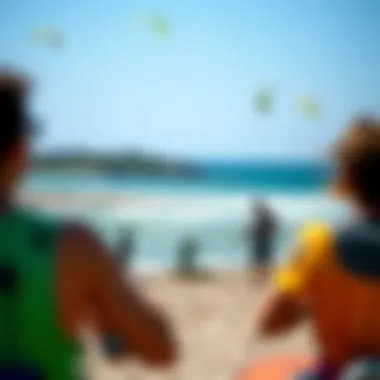

- Advanced Skill Development: They often find that using the trainer kite allows them to work on specific maneuvers without the pressure of managing a full-sized kite.
- Wind Management Skills: Veteran kiteboarders acknowledge that training with the Ocean Rodeo makes them acutely aware of wind patterns, ultimately leading to improved performance in diverse conditions.
- Durability and Reliability: Many seasoned kiteboarders also highlight the durability of the fabric and stitching of this trainer kite. "After months of use, it still looks brand new. That's a win in my book," said one athlete.
In summary, the testimonials from both novices and experienced kiteboarders underscore the Ocean Rodeo Trainer Kite's role in fostering skill development, community engagement, and confidence building in kiteboarding. As potential kite enthusiasts read through these experiences, they can glean valuable insights that may help guide their own decisions and training endeavors.
Comparisons with Other Trainer Kites
In the world of kiteboarding, there is a wide variety of trainer kites, and the Ocean Rodeo Trainer Kite stands out for quite a few reasons. Comparing this model with others on the market can shed light on its design, usability, and effectiveness for both novices and seasoned kiteboarders.
Why should one weigh these differences? Well, understanding how the Ocean Rodeo Trainer Kite stacks up against its competitors gives insights into what features to look for, what performance metrics are essential, and how to choose a kite that aligns with personal goals and skill levels.
Some key elements to consider in these comparisons include flight stability, ease of use, and the learning curve associated with each kite. A trainer kite’s ability to remain steady in various wind conditions is crucial for mastering flying techniques, while user-friendly designs facilitate a smoother introduction into the sport.
"In the high winds where other kites might falter, the Ocean Rodeo Trainer maintains its composure, allowing users to focus on skill development rather than wrestling with their gear."
When exploring these features, one must also think about adaptability. For someone just starting, a kite that handles beautifully might not translate well into more advanced uses. This is where the unique design and capabilities of the Ocean Rodeo come into play when favorably positioned against other trainer kites.
Performance Metrics
To truly appreciate the Ocean Rodeo Trainer Kite, one must scrutinize its performance metrics relative to other trainer kites. The performance standards include attributes like:
- Lift Capacity: The ability of the kite to elevate against the wind.
- Speed and Responsiveness: How quickly the kite reacts to steering input.
- Wind Range: The spectrum of wind conditions where the kite functions optimally.
For example, the Ocean Rodeo Trainer is known for its impressive lift capacity, providing both novice and intermediate users with enough support to explore various flying techniques without feeling overpowered. In direct competition, some trainer kites lack the speed and responsiveness needed to facilitate smoother transitions in turns or maneuvers, making the Ocean Rodeo an appealing choice.
Cost vs Value Analysis
Evaluating a trainer kite on the basis of cost versus value is paramount when making a purchasing decision. The Ocean Rodeo Trainer Kite offers a robust value proposition when compared to kites priced similarly, as it boasts exceptional craftsmanship, quality materials, and proven performance metrics.
- Initial Cost Considerations: While the upfront cost might be higher than entry-level kites, the durability and performance can save money on replacements in the long run.
- Long-Term Investment: The capacity to refine skills and push boundaries with a high-quality kite translates to more engaging sessions, which is invaluable for those serious about the sport.
- Resale Value: Quality goes hand in hand with resale potential. Ocean Rodeo’s reputation means that you might fetch a higher price on the secondary market when it’s time to upgrade.
Recommendations for Optimal Use
Understanding the Ocean Rodeo Trainer Kite isn't just about knowing how it looks or which beach is best for flying it; it’s about getting the most out of it as a beginner or even a more seasoned kiteboarder. Making the kite a reliable companion in your adventure is essential for both fun and safety. Here are key recommendations to ensure optimal use and a rewarding experience.
Best Practices for Beginners
For those just dipping their toes into the water, familiarity and comfort with your trainer kite can’t be overstated. Here are some tips to get you started:
- Get Acquainted with the Equipment: Before even inflating your kite, take some time to read the manual. Understanding the parts and their functions makes a world of difference.
- Choose the Right Location: Find an open space away from crowds, obstacles, and power lines. Places like public parks or beaches with wide stretches of sand are ideal navigational grounds.
- Check Weather Conditions: Wind is the kiteboarder's best friend but can be a foe as well. Aim for moderate winds, ideally around 10 to 20 mph, to allow for easier control while avoiding strong gusts.
- Practice Basic Maneuvers: Focus on simple exercises like flying the kite in a figure-eight pattern or practicing relaunching from the ground. The more you get comfortable, the more poised you’ll feel.
- Safety First: Always wear a helmet and wrist leash, especially on your first outings. Getting yourself accustomed to how the kite behaves when faced with different wind conditions can be a game changer.
Taking these steps can help you get off on the right foot, so you can focus on learning instead of worrying about mishaps.
Refining Technique with Trainer Kites
Once you’ve become familiar with the trainer kite, it's time to refine your skills. Here’s how to take things up a notch:
- Engage in Consistent Practice: Like learning an instrument, regular practice is crucial. Spend time flying the kite regularly, experimenting with different wind conditions, and refining your control.
- Gradually Increase Complexity: Once comfortable with basic maneuvers, start incorporating more advanced techniques such as power slides or jumping – while still using the trainer kite to fine-tune your body movements.
- Ask for Feedback or Instruction: Joining local kiteboarding groups or lessons can provide the necessary guidance. They can offer insights and techniques you may not have considered on your own, highlighting areas needing improvement.
- Video Yourself: Recording your sessions can provide valuable perspective. When you watch yourself, you'll notice things you can improve upon and track your progress over time.
- Experiment with Line Length: Changing the length of your lines can alter the kite's responsiveness and tuning. Understanding these dynamics can further enhance your skill set.
As you embark on this journey, remember that persistence is key. Practice steadily, learn from every flight, and you'll not only sharpen your techniques but also build confidence to tackle greater challenges.
"The journey of a thousand miles begins with a single step." – Lao Tzu
By following these strategies, it’s possible to harness the full potential of the Ocean Rodeo Trainer Kite, enhancing your overall kiteboarding experience while ensuring enjoyable and safe adventures along the way.
For more insights on kiteboarding, you might want to explore resources found on Wikipedia or community discussions on Reddit.
Epilogue: The Role of Trainer Kites in Kiteboarding
The significance of trainer kites in the realm of kiteboarding cannot be overstated. These kites are not merely tools for beginners; they transform how practitioners at all levels engage with the wind and water. One primary advantage is the ability to master fundamental skills such as control and navigation without the immediate intensity of a full kiteboarding setup. That said, for novices, the trainer kite serves as the best gateway to the exhilarating world of kiteboarding, allowing for practice in a controlled and less intimidating manner.
Trainer kites also play a pivotal role in refining skills for seasoned enthusiasts. As they navigate more advanced maneuvers, such as transitions or upwind techniques, these kites offer valuable feedback on steering and power management. Thus, they reveal subtle nuances often overlooked when using larger, more aggressive kites.
In essence, trainer kites fulfill multiple roles:
- Skill Development: They offer a platform to grasp essential kite control, steering, and responsiveness.
- Safety Training: With a smaller, less powerful kite, there is a reduced risk of accidents, making them ideal for safety drills.
- Preparation for Advanced Kiting: They lay the groundwork needed for tackling larger kites, instilling confidence in users.
"Trainer kites provide the fundamental principles of kite control without the immediate pressures of kiteboarding."
Overall, it's clear that the role of trainer kites extends beyond basic training; they foster an understanding of wind dynamics and equipment handling that is essential for anyone looking to excel in kiteboarding.
Summary of Key Points
- Trainer kites are essential for beginners to grasp the basics of kite control without overwhelming complexity.
- They provide a safe environment for practicing skills, critical for preventing accidents during more advanced learning.
- For experienced riders, trainer kites can be used to improve technical skills and confidence on the water.
- The feedback gained from using trainer kites can enhance overall kiteboarding performance with larger kites.
Future Developments in Trainer Kite Technology
The evolution of trainer kites appears promising, with innovations set to impact how they are constructed and utilized. Future advancements may include:
- Enhanced Materials: Lightweight yet durable fabrics that improve performance while ensuring safety during operation.
- Smart Technology: Integration of sensors or smart features enabling real-time feedback on user performance.
- Versatility: Expansion in shape and size variations to address different learning curves and environmental conditions.
- Eco-friendly Designs: A shift toward sustainable materials, promoting environmental awareness among users.
As kiteboarding continues to grow, it’s likely that the technology behind trainer kites will also evolve, making the practice even more accessible and enjoyable. Kiteboarding enthusiasts can expect thrilling developments that resonate well beyond just trainer kites, ultimately enhancing the kiteboarding experience as a whole.
For more insights and updates on kiteboarding technology, consider visiting Kitesurfing Wiki or forums like Reddit’s Kiteboarding Community.








